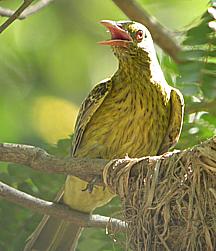Australasian Yellow Oriole
|
|
| Yellow Oriole | ||||||||||||||
|---|---|---|---|---|---|---|---|---|---|---|---|---|---|---|
 | ||||||||||||||
| Scientific classification | ||||||||||||||
| ||||||||||||||
| Binomial name | ||||||||||||||
| Oriolus flavocinctus (Vigors, 1826) |
The Yellow Oriole or Green Oriole, (Oriolus flavocinctus) is an inconspicuous inhabitant of lush tropical vegetation throughout New Guinea and northern Australia, including Cape York Peninsula, the Top End and the Kimberley.
This species should not be confused with the South American Yellow Oriole, which is an icterid.
Yellow Orioles forage slowly and methodically through the mid and upper strata of dense forests, taking fruit in the main. Typically alone or in pairs, they sometimes form small flocks in the non-breeding season. They are often difficult to locate, as their yellow-green plumage blends with the foliage and only their bubbling muisical calls can be heard. They are nevertheless common in suitable habitat: rainforests, mangroves, thickets along watercourses, swamps, and lush gardens.
Breeding takes place during the wet season (October to March). A neat, deep cup is constructed from strips of bark and vines, lined with rootlets, and slung between leafy branches, usually 5 to 15 metres up. They typically lay 2 eggs.
